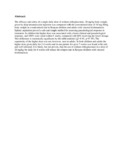| dc.contributor.author | Anabwania, GM | |
| dc.contributor.author | Dimitia, G | |
| dc.contributor.author | Ngira, JA | |
| dc.contributor.author | Bryceso, ADM | |
| dc.date.accessioned | 2013-06-30T08:46:13Z | |
| dc.date.available | 2013-06-30T08:46:13Z | |
| dc.date.issued | 1983-01 | |
| dc.identifier.citation | The Lancet Volume 321, Issue 8318, 29 January 1983, Pages 210–212 | en |
| dc.identifier.uri | http://www.sciencedirect.com/science/article/pii/S0140673683925886 | |
| dc.identifier.uri | http://erepository.uonbi.ac.ke:8080/xmlui/handle/123456789/42776 | |
| dc.description.abstract | The efficacy and safety of a single daily dose of sodium stibogluconate, 20 mg/kg body weight, given by deep intramuscular injection was compared with the conventional dose of 10 mg Sb/kg body weight in a randomised trial in Kenyan children and adults with visceral leishmaniasis. Splenic aspiration proved a safe and simple method for assessing parasitological response to treatment. In children the higher dose was associated with a faster clinical and parasitological response, and 100% were cured within 4 weeks, compared with 60% receiving the lower dosage. This difference is statistically significant by life-table analysis (χ2=4·41, p<0 ·05). The superiority of the higher dose was not, however, seen in adults. In both children and adults the higher dose given daily for 2-4 weeks and in one patient for up to 7 weeks was found to be safe and well tolerated. It is likely, but not proven, that the use of sodium stibogluconate in a dose of 20 mg/kg bw daily for 4 weeks will reduce the relapse-rate in Kenyan children with visceral leishmaniasis. | en |
| dc.language.iso | en | en |
| dc.publisher | University of Nairobi | en |
| dc.title | Comparison Of Two Dosage Schedules Of Sodium Stibogluconate In The Treatment Of Visceral Leishmaniasis In Kenya | en |
| dc.type | Article | en |
| local.publisher | Department of Paediatrics | en |

